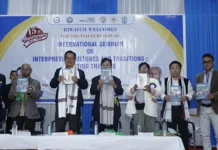[ Tongam Rina ]
The Central Board of Secondary Education (CBSE) results of Class 10 and Class 12 are a reminder to the government of Arunachal Pradesh, teachers and parents that drastic efforts have to be made to improve the education scenario in the state.
According to the education department, of the 11,153 students from 84 government higher secondary schools (GHSS) who appeared for the All India Senior School certificate Examination (AISSCE), only 4944 students have passed.
Only one out of 31 students of GHSS Talo (Lower Subansiri) cleared the AISSCE 2018, while only seven out of 176 students passed out of GHSS Bazar Line Seppa (East Kameng).
In the All India Secondary School Examination (AISSE), of the 23,829 students registered, only 8270 passed. The government-run schools had a 21.22 pass percentage. Kra Daadi had an overall pass percentage of 3.57.
The miserable statistics are mind-boggling, even though we have consistently put up bad performances in the CBSE exams over the years.
What does it say about our education system? Looking at the worrying statistics, one can figure out that there is something horribly wrong with the education system in the state – but nobody seems to know what the exact problem is.
Not everybody is a gifted child. But everyone has it in them to pass an examination, provided there is a robust support system. Unfortunately, support system is seriously lacking in our state. Physical school infrastructure apart, the state is plagued with lack of trained teachers, mostly in lower primary schools. The government perhaps is aware of the quality of teachers it has recruited in the primary level. Many in-service teachers have flunked the Arunachal Pradesh Teachers Eligibility Test, forcing the government to start mandatory training of school teachers now.
What about the role of parents? In a state where many parents are illiterate, it is difficult to ascertain their roles in the education of their children, although every parent wants the best education for their children. The state seems to have failed not only the students but the parents, as well.
Perhaps it will make a lot of difference if parents, literate or not, are involved in the education of their children.
While there are too many government schools in the state – many unnecessary and some defunct for lack of students as well as teachers – the concentration of students are mostly in urban and semi-urban areas with inadequate facilities. There are not enough classrooms, to begin with.
A school in the state capital has more than 230 students in one class, divided in three sections. By the time the mandatory roll-call is over, half of the teaching hours is gone. That apart, it is humanly impossible for a teacher to look after 70 odd students in one classroom.
In another school in Itanagar, the teaching hours for lower classes are over by 10 am because of overcrowding. What is a child supposed to do for the remaining hours of the day?
The state government seriously needs to ponder on how to improve the school education system in the state, right from the pre-primary to the higher secondary level.
What about pre-school students? With most anganwadis in the state being defunct, the state needs to consider coming up with preparatory schools or kindergartens. A child without a basic idea about the alphabet can’t be expected to read a line in Class 1, which is the case right now in the state. Unfortunately, they are expected to.
A start has to be made, right from training teachers to ensuring involvement of parents in the children’s education to infrastructure. Most of all, it is time to concentrate on preschool students, so that they are not confused when they are sent to Class 1, where it’s all about words and sentences and not letters.




